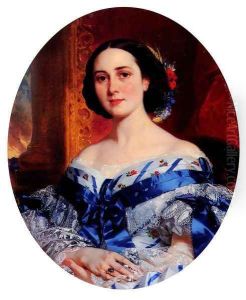Eugene Francois Marie Joseph Deveria Paintings
Eugène François Marie Joseph Devéria was a French painter known for his historical and genre paintings. He was born on April 22, 1805, in Paris, France. Devéria emerged during the Romantic period of the 19th century, which was characterized by an emphasis on emotion and individualism, as well as glorification of the past and nature.
Devéria was part of a family of artists; his brother Achille Devéria was also a painter, and they were both part of the artistic community in Paris that included figures like Eugène Delacroix and Théodore Géricault. He studied at the École des Beaux-Arts in Paris and was a student of painter Anne-Louis Girodet-Trioson.
Eugène Devéria gained early fame with his work 'The Birth of Henry IV' in 1827, which was exhibited at the Salon and earned him considerable acclaim. This painting showcased his skill in depicting historical scenes with drama and detail, and it became one of the iconic images of the Romantic movement in France.
Over time, his style evolved, and he became interested in religious themes. He was commissioned to decorate several churches in Paris, which include frescoes and other religious artworks. Despite his early success, Devéria's later career was less prominent, and he struggled with financial difficulties.
In 1855, Devéria moved to Pau in southwestern France for health reasons. There he continued to work, focusing more on portraits and local landscapes. He served as the director of the Museum of Fine Arts in Pau, where he also taught drawing.
Eugène François Marie Joseph Devéria passed away on February 3, 1865, in Pau. Although his reputation faded after his death, his early works, especially 'The Birth of Henry IV,' remain significant examples of French Romantic painting. Devéria's legacy is also observed in the influence he had on other artists of his time, and his works are preserved in various museums across France.




















